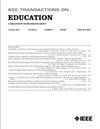Reducing the Impact of Emergency Remote Teaching Through an Understanding of Personal Digital Ecosystems
IF 2.1
2区 工程技术
Q2 EDUCATION, SCIENTIFIC DISCIPLINES
引用次数: 0
Abstract
This two-phase mixed methodology study, relevant to STEM educational stakeholders and researchers in emergency remote teaching (ERT) and ICT for education, explored college students’ and graduates’ attitudes and usage patterns of educational ICT in the U.S. and Japan and identified affordances of the technology for both text and audio-based activities of various lengths. The research was divided into two phases, with the first a qualitative analysis utilizing a questionnaire and coding, which informed the second phase, a quantitative analysis of device and activity associations utilizing通过了解个人数字生态系统减少紧急远程教学的影响
这项分两个阶段进行的混合方法研究与 STEM 教育领域的相关人员以及应急远程教学(ERT)和教育信息与通信技术(ICT)领域的研究人员息息相关,它探讨了美国和日本的大学生和毕业生对教育信息与通信技术的态度和使用模式,并确定了该技术在不同长度的文本和音频活动中的适用性。研究分为两个阶段,第一阶段是利用调查问卷和编码进行定性分析,为第二阶段的定量分析提供信息,第二阶段是利用 $k$ -均值分析对设备和活动的关联进行定量分析。研究结果表明,这些参与者对他们的个人数字生态系统有着深刻的理解,并在实践中采取了一种动态的 "能力转换 "方式,将设备与活动相匹配。当考虑到由于 ERT 而需要突然转向校外教学时,这一点令人欣慰。通过 k$ -均值分析,在六种常用设备中确定了三种主要设备,并将这三种设备与特定任务特征联系起来。笔记本电脑是最普遍的相关设备,其次是智能手机和传统的纸质非数字设备。这些发现可以为管理者在有限的预算内为学生提供 ERT 设备提供参考。
本文章由计算机程序翻译,如有差异,请以英文原文为准。
求助全文
约1分钟内获得全文
求助全文
来源期刊

IEEE Transactions on Education
工程技术-工程:电子与电气
CiteScore
5.80
自引率
7.70%
发文量
90
审稿时长
1 months
期刊介绍:
The IEEE Transactions on Education (ToE) publishes significant and original scholarly contributions to education in electrical and electronics engineering, computer engineering, computer science, and other fields within the scope of interest of IEEE. Contributions must address discovery, integration, and/or application of knowledge in education in these fields. Articles must support contributions and assertions with compelling evidence and provide explicit, transparent descriptions of the processes through which the evidence is collected, analyzed, and interpreted. While characteristics of compelling evidence cannot be described to address every conceivable situation, generally assessment of the work being reported must go beyond student self-report and attitudinal data.
 求助内容:
求助内容: 应助结果提醒方式:
应助结果提醒方式:


